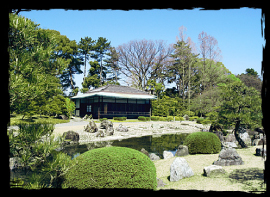 |
 |
Furnished in part by the wealthy Edo period merchant Suminokura Ryoi, this garden combines Western and Japanese styles and has two fine teahouses. |
 |
 |
The Seiryu-en Garden, employing the stone walls and turret gates of the Honmaru Palace to the south as part of its natural scenery, is located where the Tenshukaku Tower Site and the inner castle passageways were located when the castle was being constructed. Afterwards, this location was the site of the quarters for the shogunate officials, and in the Taisho Period (1912 - 1926), it was the site for banquet facilities constructed for the coronation ceremony for the Emperor Taisho. In addition, Ogawa Jihei (1860 - 1933), considered the pioneer of modern Japanese gardens, was involved in the construction of the present form of the garden.
Completed in 1965 in its present form, the Seiryu-en Garden combines Western and Japanese styles as it has a Western style section with grass on the east side and a Japanese style section on the west side with a two-story building. A part of the residence of the wealthy Edo Period merchant Suminokura Ryoi and about 800 garden stones were donated to the garden. About 300 other high-quality stones were gathered from all over the country to complete the construction.
From the Waraku-an Teahouse, used for public tea ceremonies and to entertain guests of the state, you can view the garden to the east and the Koun-tei Teahouse to the west. This teahouse was dismantled at the former residence of Suminokura Ryoi and then transferred to its present location for reconstruction in the Seiryu-en Garden. |
| |
|
|
 |
 |
| Koun-tei (Koun Teahouse) seen from Kanrankoji Street |
|
| |
|

